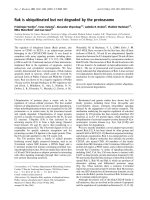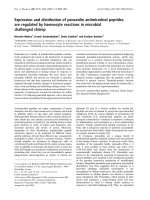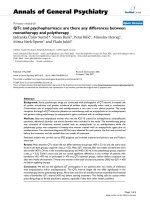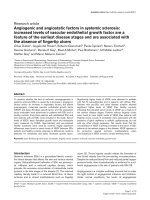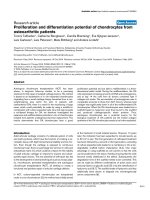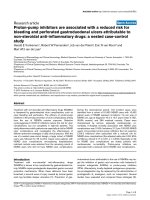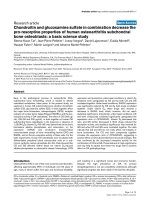Báo cáo y học: "Intelligence and ambition are distributed equally around the globe" ppt
Bạn đang xem bản rút gọn của tài liệu. Xem và tải ngay bản đầy đủ của tài liệu tại đây (178.92 KB, 2 trang )
EDI T O R I A L Open Access
Intelligence and ambition are distributed equally
around the globe
Kuan-Teh Jeang
Abstract
The impact of freely accessible knowledge distribution platforms is briefly discussed.
At a recent international conference, I heard former
United States president Bill Clinton speak. As a part of
his remarks, Clinton commented that in his visits to
many developing countries around the world he has
found that “The distribution of intelligence and ambi-
tion around the world is equal, but the ac cess to opp or-
tunities is not” (my paraphrasing). Clinton’ spoint
echoes a message of Malcolm Gladwell’s book “Out-
liers” ; both argue that a critical key to success is less
about who you are or where you are, but whether you
have (not) access to the same opportunities as others.
Open Access publishing is fundamentally about pro-
viding opportunities (i.e. knowledge) to al l in an equally
accessible platform. I have noted previously that this
principle, beyond all e lse, was the pr ime motivation for
founding Retrovirology [1]. While the Open A ccess pub-
lishing movement and its egalitarian approach to knowl-
edge disseminati on are laudable, one should not neglect
to highlight other equally worthy efforts to distribute
knowledge freely. One such remarka ble project is the
MIT OpenCourseWare (OCW) initiative .
edu) w hich provides free access via the internet to the
academic contents (video lectures, syllabus, problem
sets, exam solutions ) of approximately 2,000 courses
taught by 33 academic departments. There is an
immense demand for OpenCourseWare as evidenced
that it is being accessed 1.5 million times each month
by nearly 1 million unique visitors [2], many outside of
the United States.
The lasting impact of paradigm-changing platforms
such as Open Access and MIT OCW remains to be
quantified. On an anecdotal level, my impression from
editing Retro virology suggests that greater accessibility
does tra nslate into more impact. For instance, I exam-
ined the most accessed Retr ovirology papers ov er the
past 12 months that were published in the preceding
two years. Amongst the top nine most highly accessed
original research articles, there are three papers which
were published in either 2008 or 2009 [3-5]. These
papers have been accessed over the past year 9675,
4399, and 5909 times, respectively. Each is also in the
10% of highe st cited Retrovirology papers of a similar
vintage. Thus while papers need not be highly read in
order to be highly cited (e.g. review articles [6,7] are
highly cited without necessarily being highly accessed), a
large proportion of well cited papers is made up of
those articles that are the most frequently read.
The gratification from editing Retrovirology is the rea-
lization that Open Access and other similar information
distribution initiatives are doing well by doing good.
Acknowledgements
The opinions expressed are the author’s personal views and do not
necessarily reflect those of his employer, the National Institutes of Health
(NIH). Work in KTJ’s laboratory is supported in part by intramural funding
from the National Institute of Allergy and Infectious Diseases (NIAID). The
author thanks Mark Wainberg for a critical reading of this editorial.
Received: 10 August 2010 Accepted: 13 August 2010
Published: 13 August 2010
References
1. Jeang KT: The Retrovirology Open Access experience. Retrovirology 2009,
6:115.
2. d’Oliveira C, Carson S, James K, Lazarus J: SPORE series winner. MIT
OpenCourseWare: unlocking knowledge, empowering minds. Science
2010, 329:525-526.
3. Humbert M, Rasmussen RA, Song R, Ong H, Sharma P, Chenine AL,
Kramer VG, Siddappa NB, Xu W, Else JG, Novembre FJ, Strobert E, O’Neil SP,
Ruprecht RM: SHIV-1157i and passaged progeny viruses encoding R5
HIV-1 clade C env cause AIDS in rhesus monkeys. Retrovirology 2008, 5:94.
4. Andrew AJ, Miyagi E, Kao S, Strebel K: The formation of cysteine-linked
dimers of BST-2/tetherin is important for inhibition of HIV-1 virus release
but not for sensitivity to Vpu. Retrovirology 2009, 6:80.
Correspondence:
The National Institutes of Health, Bethesda, MD, USA
Jeang Retrovirology 2010, 7:67
/>© 2010 Jeang; licensee BioMed Central Ltd. This is an Open Access article distributed under the terms of the Creative Commons
Attribution License ( which permits unrestricted use, distr ibution, and reproduction in
any medium, provided the original work is properly cited.
5. Hohn O, Krause H, Barbarotto P, Niederstadt L, Beimforde N, Denner J,
Miller K, Kurth R, Bannert N: Lack of evidence for xenotropic murine
leukemia virus-related virus (XMRV) in German prostate cancer patients.
Retrovirology 2009, 6:92.
6. Goila-Gaur R, Strebel K: HIV-I Vif, APOBEC, and intrinsic immunity.
Retrovirology 2008, 5.
7. Foster JL, Garcia JV: HIV-1 Nef: at the crossroads. Retrovirology 2008, 5.
doi:10.1186/1742-4690-7-67
Cite this article as: Jeang: Intelligence and ambition are distributed
equally around the globe. Retrovirology 2010 7:67.
Submit your next manuscript to BioMed Central
and take full advantage of:
• Convenient online submission
• Thorough peer review
• No space constraints or color figure charges
• Immediate publication on acceptance
• Inclusion in PubMed, CAS, Scopus and Google Scholar
• Research which is freely available for redistribution
Submit your manuscript at
www.biomedcentral.com/submit
Jeang Retrovirology 2010, 7:67
/>Page 2 of 2

